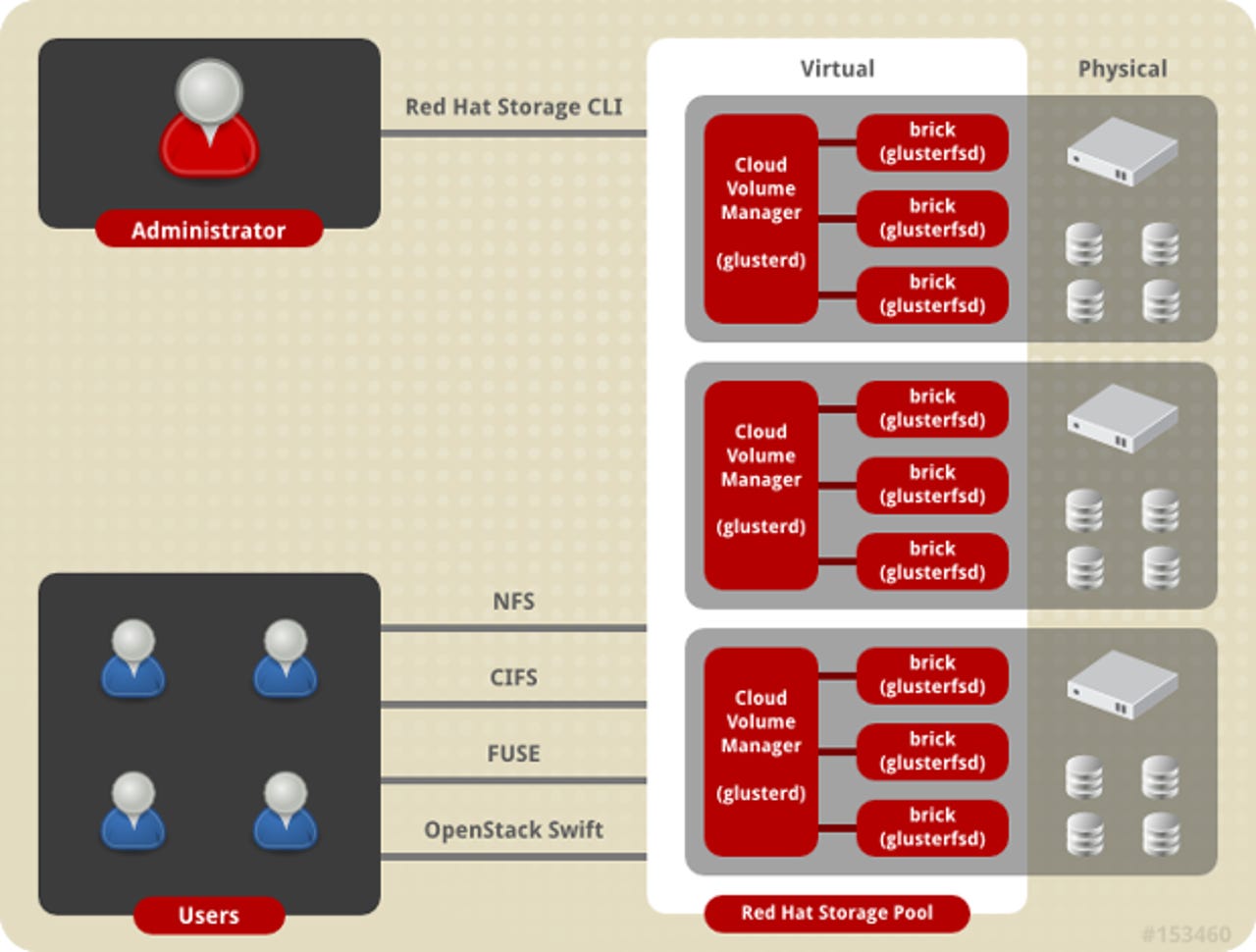Red Hat Storage Server 3: Not your usual software-defined storage

Remember when gigabyte drives were big? Recall when a terabyte of storage was enormous? Those days are long gone when your business is moving to petabytes. To manage that kind of storage you need a program that can handle "scale-out" file storage. For your colossal storage needs, Red Hat has a new open source, software-defined storage manager: Red Hat Storage Server 3 (RHSS).

This new RHSS can run on your commerical off-the-shelf (COTS) x86 servers, and on OpenStack or Amazon Web Services (AWS) cloud. It's based on open source Red Hat's GlusterFS 3.6 file system and Red Hat Enterprise Linux (RHEL) 6. Red Hat claims that RHSS 3 can "easily scale to support petabytes of data and offer granular control of your storage environment while lowering the overall cost of storage."
Its new features include:
- Increased scale and capacity by more than three times with support for up to 60 drives per server, up from 36, and 128 servers per cluster, up from 64, providing a usable capacity of up to 19 petabytes per cluster.
- Improved data protection and operational control of storage clusters, including volume snapshots for point-in-time copy of critical data and comprehensive monitoring of the storage cluster using open, industry standard frameworks, such as Nagios and SNMP.
- Easy integration with emerging big data analytics environments with support for a Hadoop File System Plug-In that enables running Apache Hadoop workloads on the storage server, as well as tight integration with Apache Ambari for management and monitoring of Hadoop and underlying storage.
- More hardware choice and flexibility, including support for SSD for low latency workloads, and a significantly expanded hardware compatibility list (HCL) for greater choice in hardware platforms.
- Rapid deployment with an RPM-based distribution option offering maximum deployment flexibility to existing RHEL users. Customers can now easily add Red Hat Storage Server to existing pre-installed RHEL deployments.
Red Hat recommends RHSS 3 for the following workloads:
- Cold Storage for Splunk Analytics Workloads
- Hadoop Compatible File System for running Hadoop Analytics
- ownCloud File Sync n' Share
- Digital multi-media (video, audio, pictures) serving (e.g., content delivery networks, online radio)
- Disaster Recovery using Geo-replication
- Live virtual machine image store for Red Hat Enterprise Virtualization
- Large File and Object Store (using either NFS, SMB or FUSE client)
- Active archiving and near-line storage
- Backup target for Commvault Simpana
- Enterprise NAS dropbox & object Store/Cloud Storage for service providers
The company also comes right out and admits that RHSS is not for every file system job. How refreshing! The workloads to avoid are those that are:
- Highly transactional like a database
- IOPS (Input/Output Operations Per Second) intensive
- Write-mostly and involve a lot of contention
- Involve a lot of directory based operations and small files
Tech Pro Research
The net result of all this, according to a statement by 451 Research's storage research VP Simon Robinson, is that since enterprises now want their IT stack to look and act like a cloud, "the storage infrastructure must support this change. Within many enterprise IT departments, this is prompting a fundamental rethink of storage strategy. Red Hat's software-defined storage portfolio offers an open-source alternative to proprietary technology stacks to address mounting challenges around the growth of enterprise data."
This is more than just a product release. Red Hat also announced that it's partnered with Splunk, Hortonworks, and ownCloud to create RHSS 3-based enterprise programs for log and cyber-security analytics, Apache Hadoop, and enterprise file sharing and collaboration programs, respectively.
OwnCloud, an open source cloud company, which is using RHSS3 to integrate with its own private Infrastructure-as-a-Service (IaaS) cloud, is a living example of Robinson's point. Together, ownCloud and Red Hat enables you to leverage your existing straphe infrastructure, with such local server standards as LDAP/AD, SAML, Database, NFS, CIFS, while being able to scale out to RHSS storage.
In a study run on HP ProLiant SL4540 servers, the two companies found that their paired storage options with 40,000 concurrent users saw excellent cost of ownership (TCO) improvement by converging the application server and storage server tiers onto the same servers, compared to traditional solutions with separate storage server appliances.
Want to see it for yourself? The companies have published a reference architecture so you can try deploying ownCloud Enterprise Edition and Red Hat Storage Server 3 for yourself.
So, if you're interested in serious storage management, I recommend giving RHSS 3 a long, hard look. It will be worth your time and attention.
Related Stories:
- Red Hat CEO announces a shift from client-server to cloud computing
- Red Hat subscription revenue continues to climb amid positive Q2 earnings
- Cisco, Red Hat broaden partnership, eye integrated OpenStack systems
- ownCloud 7 pulls in users and open source developers
- Red Hat releases new cloud-friendly Red Hat Storage